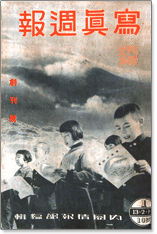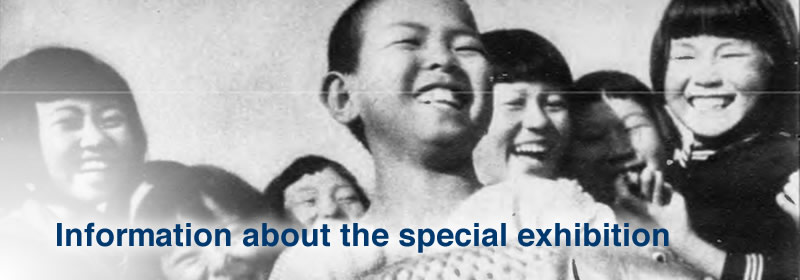 |
|
 |
|
|
First issue of Shashin Shuho |
|
 |
 |
Shashin Shuho (Weekly Photographical Journal), which was added to the historical records provided by JACAR in 2006, is a weekly pictorial journal that was published by the Cabinet Intelligence Department, the predecessor of the Cabinet Intelligence Bureau. The first issue was published on February 16, 1938, and the final issue, No. 374/375 was published on July 11, 1945. You can browse the image materials for 351 of the 370 issues of Shashin Shuho on the JACAR website. The 351 viewble issues are all kept at the National Archives of Japan, ranging from the very first issue to issue No. 352 published on December 20, 1944. |
 |
 |
 |
See the organizational changes in the Cabinet Intelligence Bureau and how Shashin Shuho was started by tracing the development of the publicity activities of the prewar Japanese government. |
 |
Learn about major events during the period between the start of the Sino-Japanese War in 1937 and the end of the Pacific War in 1945 through Shashin Shuho and many other materials. |
 |
View photos and articles from Shashin Shuho about select topics. There is also variety of other related documents. |
Learn about social conditions
through advertisements |
 |
The many different ads in the journal show what was happening at that time. |
| Cancellation of the Tokyo Olympics |
 |
Learn about the campaign to host the 1940 Olympics in Tokyo and the events leading up to its cancellation. |
Everyday lives of people as seen
through Shashin Shuho |
 |
See how people lived during the war, such as the clothes they wore and the food they ate. |
| Famous figures appearing in Shashin Shuho |
 |
Introduction to famous figures who appeared in Shashin Shuho and related documents. |
| Shashin Shuho as a medium |
 |
Covers and characteristic articles that convey the essence of Shashin Shuho. |
 |
The reference room presents data on materials and documents that are used in the special exhibition. |
| Shashin Shuho article list |
 |
This is a list of all articles of the issues of Shashin Shuho that can be viewed on the JACAR website (First issue to issue No. 352).
Images for all volumes can be viewed here. |
| Bibliography |
 |
This is a list of the literature cited in preparing this special exhibition. |
 |
Survey on the special exhibition. |
Shashin Shuho and the numerous other materials on display in this special exhibition contain many different statements and thoughts regarding international relations, culture, and society that are based on the view of the Japanese government at that time. Our hope is for these materials to help you learn about how people lived in the early Showa period. None of the representations in these materials are meant to convey our own philosophy or stance. Likewise, none of the explanations are meant to serve as specific interpretations or images of the materials and events. |


 |
Shashin Shuho, which was added to the historical records provided by JACAR in 2006, is a weekly pictorial journal that was published by the Cabinet Intelligence Department, the predecessor of the Cabinet Intelligence Bureau. The first issue was published on February 16, 1938, and the final issue, No. 374/375 was published on July 11, 1945. You can browse the image materials for 351 of the 370 issues of Shashin Shuho on the JACAR website. The 351 viewble issues are all kept at the National Archives of Japan, ranging from the very first issue to issue No. 352 published on December 20, 1944.
Whenever we examine Shashin Shuho today, we need to remember that it was made to fulfill part of the government’s publicity policy (see the comment on the first issue of Shashin Shuho, which literally translates from Japanese as “an earnest desire to promote enlightening publicity through photographs”). However, some of the many photos taken by government agency news departments, photographers such as Ihei Kimura and Ken Domon, and the average readers continue to captivate us today.
Taking the aforementioned characteristics of Shashin Shuho into consideration, the first thing this special exhibition seeks to do is to portray the changes in government agencies responsible for implementing publicity policies, such as the publication of Shashin Shuho, by making reference to the official documents provided by JACAR.
The historical events that occurred in the period from right before the publication of the first issue of Shashin Shuho in 1937 to the final issue in 1945 are organized into a timeline. The timeline contains links to Shashin Shuho articles about these events and other related documents selected from among the materials provided by JACAR.
The “Topics” section contains photos and articles from Shashin Shuho that provide a straightforward representation of specific aspects of social conditions at the time. There are also links to other related materials from the JACAR collection.
The photos and documents mentioned above are only part of the historical materials provided by JACAR. If you want to learn more about specific photos or materials, please feel free to use our search system to find related documents. Exposure to a wide range of historical materials will help to broaden your perspective. We would like nothing more than to see this special exhibition encourage people to make greater use of the resources available at JACAR. |

We have a digital archive on the Internet that offers a database of computerized images and bibliographies. To view the list of Shashin Shuho issues, click [Search] on the top page of our website. Using [Layered Information] on the search screen, select [National Archives of Japan], [Naikaku Bunko (Cabinet Library)], and then [Cabinet Intelligence Bureau Related Publications]. Shashin Shuho (Reference code: A06031059500) is the sixth item on the list that is displayed. This will give you access to all 351 issues of Shashin Shuho available on the JACAR website, including issue No. 352, which was combined with issue No. 351.
Go to [Reference Room] for the special exhibition. You can view any of the articles on the Shashin Shuho article list. Click the image of the specific issue you wish to read. |

|
|  |


